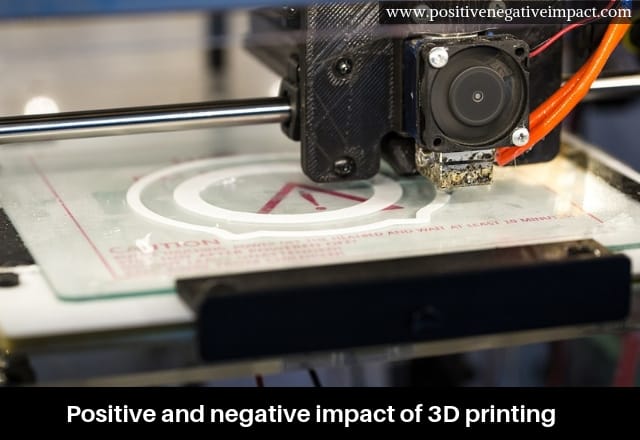3D printing is a mechanical process that manufactures multidimensional objects from blueprints or models. It has certainly become extremely popular in the last few years and has even been immortalized in several movies. But even though the advantages of manufacturing 3D objects from models and blueprints are obvious, it still has a few negatives. That’s why we need to take a closer look at some of the positives and negatives of 3D printing.

The Positive Impact of 3D Printing
- Options: It allows for more manufacturing options; with 3D printing, you can custom make your product in no time at all. With 3D printing, you can custom build your own products, make the necessary adjustments and even mass produce the same. At the moment 3D applications are limited, but it is fully expected to be more widely used in the near future.
- Decentralized: Since 3D printing is based on models and even virtual blueprints, there is no need to house specific parts as all are manufactured in the 3D printing process. Moreover, you would not be required to retain older models, since all that the machine would need is a virtual blueprint. In the future, it is expected that manufacturers would migrate away from traditional models of manufacturing towards 3D printing and would no longer require extensive warehouses to store their products as all can be manufactured on site and on demand. It would still be a while before 3D printing becomes widely utilized but given the demand, it would only be a matter of time before that happens and not a question of weather. With 3D printing, the manufacturing process would become increasingly decentralized and this would benefit both the companies and the consumers.
- Rapid prototyping: With 3D printing, both companies and individuals can now rapidly create prototypes for their design. This should help cut down on valuable time in the lifecycle of a product thereby resulting in shorter time for the product to make its way from the design board to the market.
- Cost: Given that with 3D printing, companies no longer have to shell out for large overheads, it was only to be expected that the cost of 3D printing would be less. It is now expected that the overall cost would be even less than cheap labour but as to the question if this would translate to the actual price depreciation on various products, manufactured by 3D printing is yet to be known.
Negative Effects of 3D Printing
- Limitations: At the moment, 3D printing can only print in certain types of materials such as Resin, Ceramic, plastic and certain metals. More research is currently underway and it is expected that the range of materials will see a sharp increase over the next few years.
- Loss of jobs: It is widely expected that with the advent of 3D printing and various other automation technology, there would be a sharp decrease in manufacturing industries. As companies become more reliant on 3D printing and have already started running several manufacturing units by utilizing automation technology rather than manual labour, more people are bound to lose their jobs in the manufacturing sector.
- Copyright: Since by theory anyone can own a 3D printing unit, it would be very easy to produce a counterfeit that looks just like the original and no one can tell them apart. In fact, it would be nearly impossible to do so. At the moment 3D printing is still in its nascent stage, but once it is widely adopted across several key industries, copyright issues are bound to flare up.
- Dangerous items: It is technically feasible to produce a knife or a gun using 3D printing which only underscores the fact that this technology can be misused to the point that it can constitute a danger to all of us. Since no item is being transported across borders, there are no customs to declare. Essentially this means that anyone can produce firearms in their residence using 3D printing and sell it to the black market. As mentioned earlier, 3D printing is still in its nascent stages but it is evident that there would have to be some regulations governing the same.
These are the positive and negative impacts of 3D printing; 3D printing is part of our reality and it is only a matter of time before it sees widespread applications across several verticals.
Latest posts by Alan Behrens (see all)
- Tulip Mania – The Story of One of History’s Worst Financial Bubbles - May 15, 2022
- The True Story of Rapunzel - February 22, 2022
- The Blue Fugates: A Kentucky Family Born with Blue Skin - August 17, 2021
